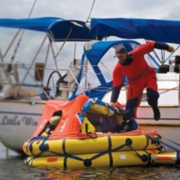Sinking
A boat sits down in the water until it has displaced the same weight of water as the weight of the boat. It is a universal arrangement between boat and water, “You stay out and I will stay on top.” When there is a breakdown in that agreement, a potential emergency arises.
Getting a hole in the hull (being “holed”) can be minor or catastrophic. Often finding where the hole is can be a major problem. The first place to look is seacocks and sink drain pipes. The wood plugs stored in your emergency kit are used for driving into a burst seacock.
Tough DiagnosisOnce under sail, I stepped down to the cabin to grab a drink and into 6 inches of water covering the cabin floor. After a serious diagnosis, I found that a drain pipe had slipped off the bottom of the forward bathroom sink. Water was coming in through the drain seacock, but only when we were heeling to port. You can’t even imagine how difficult it was to determine the source of that breakdown. |
If the issue is not a seacock, continue your search and look for flowing water. Stuff anything flexible like clothing or foam mattresses in the hole to reduce the flow. Chances are that you can stuff enough in the hole to slow down the water entry so the bilge pumps can keep up. However, should the hole be inaccessible or too large to patch, you may have to consider using a variety of pumps, buckets, and potential abandonment.
Safety Preparation TipWhether on your own boat or if chartering, inspect the boat and diagram ALL of the potentially hazardous holes below the waterline. This includes seacocks for intakes and drains as well as thru-hulls such as speed and depth transducers, prop and rudder placements, and even keelbolts. If orienting a new crew, consider printing blank diagrams and having them search and diagram the boat themselves. Simply, it’s important to find and defend against the source of water intrusion QUICKLY. |
For whatever reason, should your vessel begin taking on copious amounts of water and sinking is a possibility, you must do something fast. If you have a dinghy or life raft, make it ready for use should it become necessary.
Because of the many air pockets in a modern vessel, it is unlikely it will truly sink. Abandon the vessel only if conditions become impossible. Stay with the vessel even if it maintains minimal floating. You are more likely to be seen by rescue aircraft if you stay with the vessel. If you are in a dinghy or life raft, tie it to the floating vessel but make sure the knot is easily undone and you have a knife available to cut the dinghy painter (line) in case the vessel sinks.

A life raft will usually have a sea drogue on board. This is a water anchor which slows the life raft from drifting away from the sinking area. It will also stop the life raft from capsizing and give the life raft stability in large wave conditions. It also keeps the tent opening facing downwind.
Luckily, sinking is rare. But this does not absolve the skipper from having a plan for serious events. A ditch bag or grab-bag is an essential part of a ship’s permanent inventory.
Prior to abandoning the ship, things to take:
- Ditch-bag.
- Water and food.
- Communication devices (should be in the ditch bag).
- Other useful items such as warm clothing.
Things to do:
- Get life jackets on everyone.
- Send a mayday.
- Fire flares.
- Check the painter is tied to the vessel.






